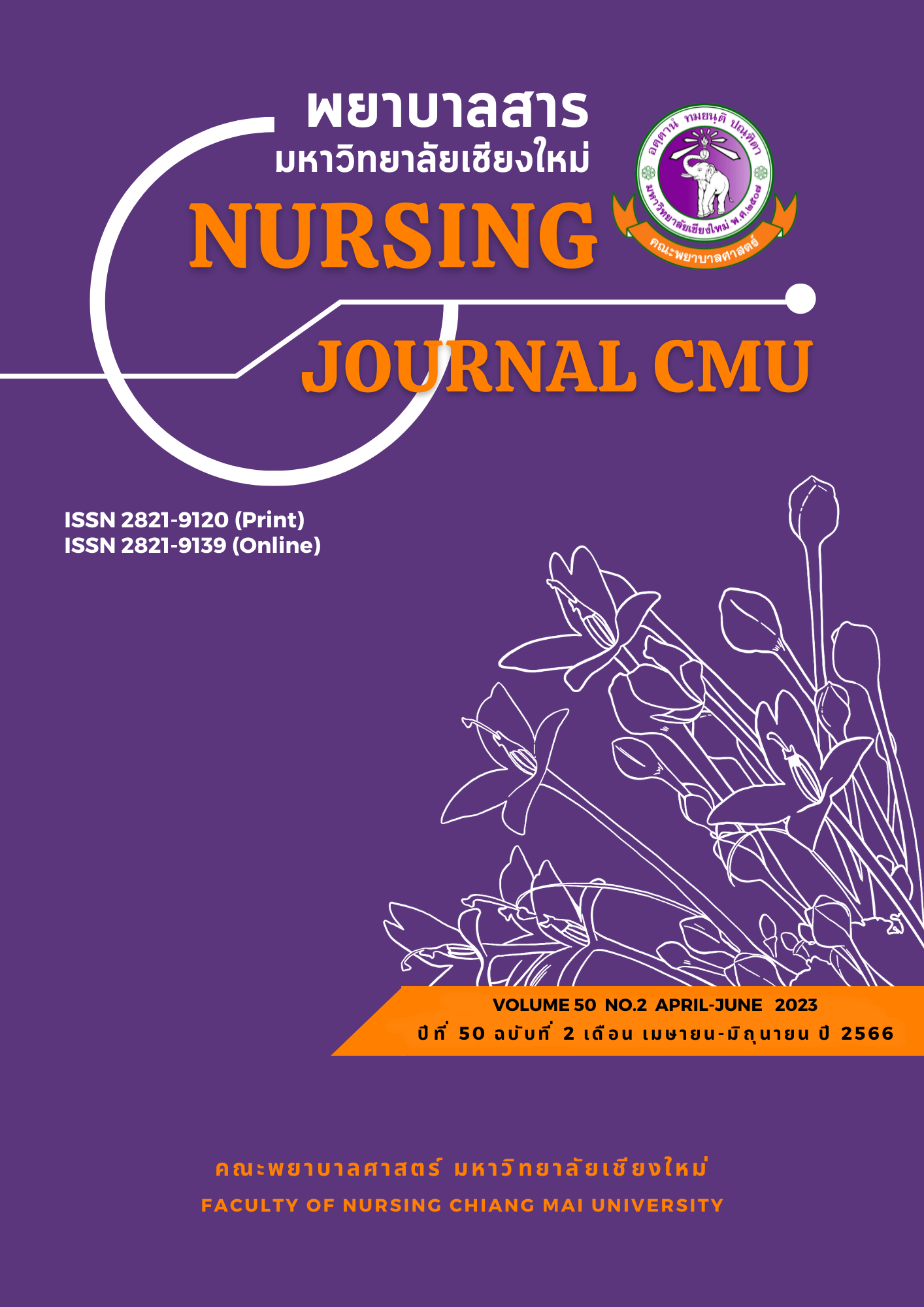Physical Literacy and Physical Activities Among Older Persons with Hypertension
Keywords:
Physical literacy, Physical activities, Older persons with hypertensionAbstract
Physical literacy is one of the factors that ensures a person’s proper and continuous practice of physical activities. This correlational descriptive research aimed to examine the physical literacy and physical activities, and the association between the physical literacy and physical activities, among older persons with hypertension. Participants in this study were 84 older persons with hypertension attending a sub-district health promoting hospital in Mae Rim District, Chiang Mai Province, and selected using simple random sampling from June to September 2022. The research instruments used in this study included a demographic and illness data recording form, a questionnaire on perceived physical literacy, and a questionnaire on physical activity of older persons with hypertension. Data were analyzed using descriptive statistics and Pearson’s product-moment correlation.
The results showed that participants had a moderate level of physical literacy and a high level of physical activities. Physical literacy had a positive, moderate, statistically significant correlation with physical activities (r = 0.318, p < .01).
The results provide basic information for health personnel in planning for promoting physical literacy to maintain appropriate physical activities among older persons with hypertension.
References
Aekplakorn, P. (2021). 2019 – 2020 The 6th national health examination survey. Nonthaburi: Health systems research institute. (in Thai)
American College of Sports Medicine., Chodzko-Zajko, W. J., Proctor, D. N., Fiatarone Singh, M. A., Minson, C. T., Nigg, C. R., … Skinner, J. S. (2009). American College of Sports Medicine position stand. Exercise and physical activity for older adults. Medicine and Science in Sports and Exercise, 41(7), 1510-1530. doi: 10.1249/MSS.0b013e3181a0c95c
Brislin, R. W. (1970). Back-translation for cross-cultural research. Journal of Cross-CulturalPsychology, 1(3), 185-216.
Chanhom, J. (2018). Factors affecting physical activity among people with risk of hypertension in Muang District, Lampang Province. Thai Science and Technology Journal, 28(3), 546–560. (in Thai)
Chla-em, T., Leelukkanaveela, Y., & Homsin, P. (2017). Factors associated with physical activity among elderly people in Banggrasor Sub - District, Mueng District, Nonthaburi Province. Journal of Nursing and Education, 10(2), 19–32. (in Thai)
Cohen, J. (1988). Statistical power analysis for the behavioral science (2th ed.). Hillsdale, NJ: Lawrence Erlbaum Associates.
Department of medical service. (2014). Barthel Activity of Daily Living: ADL. Retrieved from http://dmscaretools.dms.go.th/geriatric/download/DMS_Aging_screening. pdf (in Thai)
Edwards, L., Bryant, A., Keegan, R., & Morgan, K. (2017). Definitions, foundations and associations of physical literacy: A systematic review. Sports Medicine, 47(1),113–126.
Estefania, O., Hena, P., Stella, K., Fugar, A., Alan, G., Nidhi, M., & Kim, A. W. (2019). Hypertension in older adults: Assessment, management, and challenges. Clinical Cardiology, 43(2), 99-07.
Hegde, S. M., & Solomon, S. D. (2015). Influence of physical activity on hypertension and cardiac structure and function. Current Hypertension Reports. 17(10), 77.doi: 10.1007/s11906-015-0588-3
Holler, P., Jaunig, J., Amort, F. M., Tuttner, S., Hofer-Fischanger, K., Wallner, D., … Moser, O. (2019). Holistic physical exercise training improves physical literacy among physically inactive adults: A pilot intervention study. BMC Public Health, 19(1), 393.
Jones, G. R., Stathokostas, L., Young, B. W., Wister, A. V., Chau, S., Clark, P., … Nordland, P. (2018). Development of a physical literacy model for older adults-a consensus process by the collaborative working group on physical literacy for older Canadians. BMC Geriatrics, 18(1), 13. doi: 10.1186/s12877-017-0687-x
Ma, R. S., Sum, R. K., Li, M. H., Huang Y., & Niu, X. L. (2020). Association between physical literacy and physical activity: A multilevel analysis study among Chinese undergraduates. International Journal of Environmental Research and Public Health, 17(21), 7874. doi: 10.3390/ijerph17217874
Pansakun, N., & Kantow, S. (2020). The relationship between personal factors and physical activity levels among patients with non–communicable diseases, Phrae Province. Songklanagarind Journal of Nursing, 40(2), 66-82. (in Thai)
Pfeiffer, E. (1975). A short portable mental status questionnaire for the assessment of organic brain deficit in elderly patients. Journal of the American Geriatrics Society, 23(10), 433-441.
Roetert, E., & Ortega, C. (2019). Physical literacy for older adult. Strength and Conditioning Journal, 41(2), 89–99.
Santoso, N., Thongpat, S., & Wattanakul, B. (2015). Predictors of physical activity in older people with hypertension, Bantul, Indonesia. Journal of Health Research, 29(Suppl.1), S7–S13.
Sinsap, N., Jankra, J., & Jaiman, B. (2019). Physical activity for longevity in the elderly. The Journal of Baromarajonani College of Nursing, Nakhonratchasima, 25(2), 229–246. (in Thai)
Stathokostas, L., Gotz, A., & Clark, P. (2020). What exactly is physical literacy? Perspectives from older adults and those who work with older adults. Retrieved from https://www.activeagingcanada.ca/assets/pdf/practitioners/physical-activity-literacy/ Physical-Literacy-and-Older-Adults.pdf
Teabput, K. (2021). Validation and invariance analysis of causal model among physical activity in university students. Journal of Health, Physical Education and Recreation, 47(2), 261–272. (in Thai)
Thai Hypertension Society. (2019). 2019 Thai guidelines on the treatment of hypertension. Bangkok: Author. (in Thai)
Visuthipanich, V., Leethongin, G., & Supicha, W. (2012). Testing of international physical activity questionnaire short form among Thai population age range from 15 to 65 years old. Journal of Faculty of Physical Education, 15(Suppl.), 427–438. (in Thai)
Wang, H., & King, B. (2019). Perceived physical literacy for Chinese elderly questionnaire development: Preliminary validity and reliability. Innovation in Aging, 3(Suppl.1), S523.
Whitehead, M. (2013). Definition of physical literacy and clarification of related issues. Journal of Sport Science and Physical Education, Bulletin, 65, 28–33.
World Health Organization. (2010). Global Recommendations on Physical activity for health. Switzerland: WHO.
World Health Organization. (2020). WHO guidelines on physical activity and sedentary behavior. Geneva: Author.
Zhou, B., Perel, P., Mensah, G. A., & Ezzati, M. (2021). Global epidemiology, health burden and effective interventions for elevate blood pressure and hypertension. Natural Reviews Cardiology, 18(11), 785–802. doi: 10.1038/s41569-021-00559-8
Downloads
Published
How to Cite
Issue
Section
License
Copyright (c) 2023 Nursing Journal

This work is licensed under a Creative Commons Attribution-NonCommercial-NoDerivatives 4.0 International License.
บทความที่ได้รับการตีพิมพ์เป็นลิขสิทธิ์ของวารสารพยาบาลสาร
ข้อความที่ปรากฏในบทความแต่ละเรื่องในวารสารวิชาการเล่มนี้เป็นความคิดเห็นส่วนตัวของผู้เขียนแต่ละท่านไม่เกี่ยวข้องกับมหาวิทยาลัยเชียงใหม่ และคณาจารย์ท่านอื่นๆในมหาวิทยาลัยฯ แต่อย่างใด ความรับผิดชอบองค์ประกอบทั้งหมดของบทความแต่ละเรื่องเป็นของผู้เขียนแต่ละท่าน หากมีความผิดพลาดใด ๆ ผู้เขียนแต่ละท่านจะรับผิดชอบบทความของตนเองแต่ผู้เดียว






